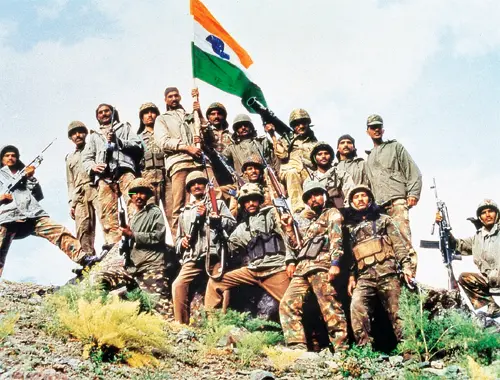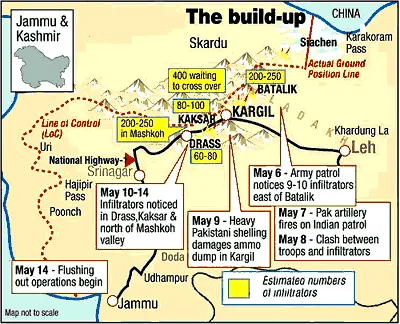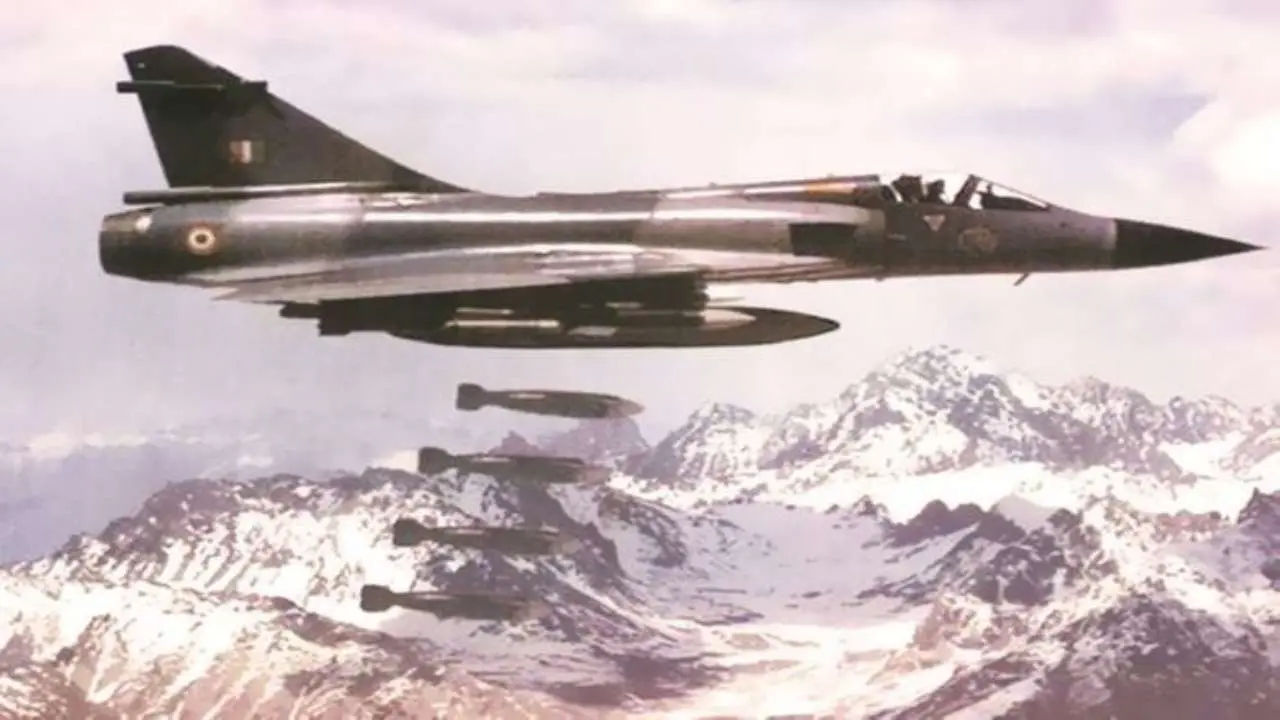The Kargil War 1999

tl;dr
Here is a brief of the war:
Outcome
| Date | |
|---|---|
| 3 May – 26 July 1999 (2 months, 3 weeks and 2 days) | |
| Location | |
| Kargil district, Jammu and Kashmir (now Ladakh), India | |
| Result | |
| Indian Victory | |
| India | Pakistan |
| Strength | |
| 30,000 | 5,000 |
| Casualties and losses | |
Indian official figures
Pakistani claims
| Independent figures
Pakistani figures
Indian claims
|
Order of Events

| Date (1999) | Events |
|---|---|
| 03 May | A Pakistani intrusion in the Kargil district is reported by local shepherds. |
| 05 May | Indian Army patrols are sent out in response to earlier reports; 5 Indian soldiers are captured and subsequently killed. |
| 09 May | Heavy shelling by the Pakistan Army damages Indian ammunition dumps in Kargil. |
| 10 May | Multiple infiltrations across the LoC are confirmed in Dras, Kaksar, and Mushkoh sectors. |
| Mid-May | India moves in more soldiers from the Kashmir Valley to Kargil district. |
| 26 May | The Indian Air Force (IAF) begins airstrikes against suspected infiltrator positions. |
| 27 May | One IAF MiG-21 and one MiG-27 aircraft are shot down by Anza surface-to-air missiles of the Pakistan Army’s Air Defence Corps; Flt. Lt. Kambampati Nachiketa (pilot of the MiG-27) is captured by a Pakistani patrol and given POW status (released on 3 June 1999) |
| 28 May | One IAF Mi-17 is shot down by Pakistani forces; four crew members are killed. |
| 01 Jun | The Pakistan Army begins shelling operations on India’s National Highway 1 in Kashmir and Ladakh. |
| 05 Jun | India releases documents recovered from three Pakistani soldiers that officially indicate Pakistan’s involvement in the conflict. |
| 06 Jun | The Indian Army begins a major offensive in Kargil. |
| 09 Jun | Indian troops re-capture two key positions in the Batalik sector. |
| 11 Jun | India releases intercepts of conversations between Pakistani COAS Gen. Pervez Musharraf (on a visit to China) and CGS Lt. Gen. Aziz Khan (in Rawalpindi) as proof of the Pakistan Army’s involvement in the infiltrations. |
| 13 Jun | Indian forces secure Tololing in Dras after a fierce battle with militias backed by Pakistani troops. |
| 15 Jun | United States President Bill Clinton forces then Prime Minister of Pakistan, Nawaz Sharif to immediately pull all Pakistani troops and irregulars out from Kargil. |
| 29 Jun | Under pressure from the federal government, Pakistani forces begin their retreat from Indian-administered Kashmir and the Indian Army advances towards Tiger Hill. |
| 04 Jul | Three Indian regiments (Sikh, Grenadiers and Naga) engage elements of the remaining Pakistani Northern Light Infantry regiment in the Battle of Tiger Hill. The region is recaptured by Indian forces after more than 12 hours of fighting. |
| 05 Jul | Pakistani Prime Minister Nawaz Sharif officially announces the Pakistan Army’s withdrawal from Kargil following a meeting with POTUS Bill Clinton. Indian forces subsequently take control of Dras. |
| 07 Jul | Indian troops recapture Jubar Heights in Batalik. |
| 11 Jul | Pakistani forces disengage from the region; India retakes key peak points in Batalik. |
| 14 Jul | Prime Minister of India Atal Bihari Vajpayee declares Operation Vijay a success. The Indian government sets conditions for talks with Pakistan. |
| 26 Jul | Kargil War officially comes to an end. Indian Army announces the complete withdrawal of Pakistani irregular and regular forces. |
Alright, ready to hear how India kicked Pakistan’s Ass? Let’s see the story.
The Story
Part 1: Infiltration
It was common practice by both India and Pakistan in those times to abandon outposts in the Winter and reoccupy them in the Spring. However, Pakistan reoccupied its outposts way earlier. And not only this, they began sending “soldiers” across the LoC and infiltrated India’s own outposts.
This is a clear lie by Pakistan as it has contradicted its own statements numerous times.
Troops from the elite Special Services Group as well as four to seven battalions of the Northern Light Infantry (a paramilitary regiment not part of the regular Pakistani army at that time) covertly and overtly set up bases on 132 vantage points of the Indian-controlled region. According to some reports, these Pakistani forces were backed by Kashmiri guerrillas and Afghan mercenaries. According to General Ved Malik, the bulk of the infiltration occurred in April.
Finally in the starting of the month of May, when Pakistan had infiltrated deep inside LoC, a local shepherd saw them and found them suspicious and informed the Army.
Indian Army sent a patrol team on his tip. Those 5 brave soldiers were captured and brutally killed by the terrorist. Army initially considered them as a small intrusion, and said they would evict them in just few days. How very wrong they were.
Part 2: Recognition
It was 6-7 May when Army finally understood the gravity of the intrusion. The Government of India responded with Operation Vijay, a mobilisation of 200,000 Indian troops, however due to the difficult terrain, soldiers divided into different platoon, company etc. resulted in only 30,000 soldiers actually participating in the war.
The large difference in the number of troops in the Indian (30,000) vs Pakistan’s (5,000) was due to the fact that these hills effectively acted as a natural fort and 6:1 number of soldiers are required to attack and to defend respectively.
Thus, Pakistan had everything in their favour in the beginning of the war: Element of Surprise, Strategic Location under their control and military backing to fulfil their ulterior motives.
Part 3: Retaliation
Due to the rough terrain and extreme cold weather, India had to mount WWII style frontal attacks which resulted in heavy losses to the Indian Army.
Indian Army
Indian Army’s first priority was to clear and take back the 132 hills overlooking the NH-1 highway which threatened to cut off Leh and provided Indian Army the backbone for supply and transport.
This resulted in Indian troops first targeting the Tiger Hill (the battle portrayed in the movie Shershah) and Tololing complex in Dras (the turning point of the battle), which dominated the Srinagar-Leh route.
This was soon followed by the Batalik-Turtok sub-sector which provided access to Siachen Glacier. Some of the peaks that were of vital strategic importance to the Pakistani defensive troops were Point 4590 and Point 5353. While 4590 was the nearest point that had a view of NH 1, point 5353 was the highest feature in the Dras sector, allowing the Pakistani troops to observe NH 1.

The recapture of Point 4590 by Indian troops on 14 June was significant, but it also resulted in the Indian Army suffering the most casualties in a single battle during the conflict.
Once India regained control of the hills overlooking NH 1, the Indian Army turned to driving the invading force back across the LOC. Some of the posts put up a stiff resistance, including Tiger Hill (Point 5140) that fell only later in the war.
Indian troops found well-entrenched Pakistani soldiers at Tiger Hill, and both sides suffered heavy casualties. After a final assault on the peak in which ten Pakistani soldiers and five Indian soldiers were killed, Tiger Hill finally fell.

The Bofors FH-77B field howitzer played a vital role, with Indian gunners making maximum use of the terrain. However, its success was limited elsewhere due to the lack of space and depth to deploy it.
Indian Air Force
There was a serious lack of co-ordination among the various branches of the Defence Forces. IAF was not involved at all in the beginning and it was only on 26th May, that IAF got the permission to attack. However, IAF Chief Air Chief Marshal AY Tipnis was strictly forbidden by the then PM Atal Bihari Vajpayee to not cross the LoC at any cost.
IAF immediately started their attack codenamed Operation Safed Sagar.
However, due to severe lack of intelligence about the weapons that the enemy had, IAF suffered huge losses intially.
Initial Losses
IAF conducted initial air strikes on the enemy position near LoC using its MiG Fleet on 27th May.
Flt. Lt. Nachiketa’s MiG-27 crashed due to an Engine Failure. He ejected and landed in enemy land and was soon captured and given the PoW (Prisoner of War) status. He was paraded on live Pakistani TV mocking IAF and India and violating Geneva Convention and released 6 days later.
However, Wg Cdr Ajay Ahuja who was leading the air strike, remained there to look for Nachiketa knowing full well about the risk of getting hit by the Pakistani Missiles. His MiG-21 too was shot down by an Stinger Shoulder fired missile and he ejected. However, he didn’t survived. His post mortem showed he had two point-blank bullet shots near his ear and chest, a cold blooded murder by Pakistani soldiers. Pakistan however denies this clear breaking of Geneva Convention.
On the very next day, one Mi-17 was also shot down killing all the 4 crewmembers aboard (2 Officers and 2 Airmen). Thus as a measure against enemy’s Man-Portable Air-Defense-System (MANPADS), IAF recalled all its attack helicopters and used their helicopter for reconnaissance and providing cover fire only.
Total Air Dominance
However, after the initial losses, IAF enjoyed almost total dominance over the skies and received no resistance from PAF.
Starting from May 30, recently bought Mirage 2000 was inducted in the war. They were equipped with Laser-Guided Bombs (LGB) as well as 250 Kg “Dumb” Bombs (Unguided). However, their “Dumb” bombs were so effective that only 9 LGB were fired in the whole war.

Such was its accuracy with dumb bombs that an LGB-equipped two-seater would join up as the tail of a 2 or 4-ship formation of other Mirages carrying between 6-12 dumb bombs each, film their attacks, and only if the results were less than optimal, or if it had spotted a Command and Control bunker on its Litening sensor / camera, let loose its LGB.
All aircraft operated at an altitude of 9-10,000 metres, (~30-33,000 feet above sea level), diving when required and pulling out well out of MANPADs range with no further losses except the initial ones.
Thus, IAF’s Operation Safed Sagar was a big success.
Indian Navy
The Indian Navy also prepared to blockade the Pakistani ports (primarily the Karachi port) to cut off supply routes under Operation Talwar. The Indian Navy’s western and eastern fleets joined in the North Arabian Sea and began aggressive patrols and threatened to cut Pakistan’s sea trade.
This exploited Pakistan’s dependence on sea-based oil and trade flows. Later, then–Prime Minister of Pakistan Nawaz Sharif disclosed that Pakistan was left with just six days of fuel to sustain itself if a full-scale war had broken out.
Thus, on 26th July 1999, Indian Army declared that all intruders were evicted and concluded the war. 26th July is celebrated as the Vijay Diwas to remember our soldier’s sacrifice and celebrate India’s win.
Background
Every war just doesn’t happen on its own. Several complicated and seemingly unrelated issues results in a war like situation. Let’s look at the Geo-Political situation at that time.
This mastermind behind this attack codenamed Operation Badr was General Pervez Musharraf who was appointed Pakistan’s Army Chief only in Oct 1998.
This was stab-in-the-back attack as PM Vajpayee was trying to improve India-Pakistan relation and had went to Pakistan recently in Feb 99 to sign the Lahore Declaration. Pakistani PM Nawaz Sharif claimed that he didn’t have any information about it and came to know about this attack only through Vajpayee’s Urgent phone call. He said that the entire plan was known to only 4 Generals including General Musharraf.
Pakistan had conducted their first Nuclear test in 1998 and thus General Musharraf may have assumed that both countries having nuclear power (India had conducted Nuclear test in secret in 1974 and in 1998) would not escalate into full-blown open war and this conflict would help in completing their motives.
General Musharraf removed PM Nawaz Sharif after a boodless coup and gained power after the war in Oct 99.
Motives
Cut Off Leh-Ladakh
National Highway NH-1 connecting Srinagar to Leh was the backbone of Indian Army’s Supply and Reinforcement to Kargil and the Siachen Troops.
Thus, if the Pakistani Soldiers damaged this highway, Leh would be completely cut-off from the rest of the India and Pakistan and cause Indian forces to withdraw from the Siachen Glacier, thus forcing India to negotiate a settlement of the broader Kashmir dispute.
We all saw how India completely wiped out Pakistan’s any chance of fulfilling this motive.
Internationalize Kashmir Issue
Pakistan hoped that any conflict in this area would Internationalize the Kashmir Issue and India would have to reach a settlement with Pakistan and give back Kashmir.
Yes this worked but completely backfired against Pakistan. PM Vajpayee’s decision not to cross the LoC was a stroke of genius and gave India an image of a peaceful country fighting against foreign intrusion. The whole world sympathised with India and Pakistan faced increasing global pressure to call off its troops from the area.
US President Bill Clinton forced PM Nawaz Sharif to call off its soldiers otherwise they would face “dire consequences”.
Reignite the Kashmiri Rebellion
It may have been to boost the morale of the decade-long rebellion in Jammu and Kashmir by taking a proactive role. It may have been to show the extremists that it was Pakistan who was the superpower there and continue fighting India.
Revenge against Operation Meghdoot
It can also be that the operation’s objective may have been retaliation for India’s Operation Meghdoot in 1984 that seized much of Siachen Glacier.
Failures and Improvement
While the war was a great success for our troops, every war has its failures and things on which India could have improved. Let’s discuss about these.
Lack of Intelligence
Indian Army was completely unaware of Pakistan’s intrusion until it was very late and Pakistani had captured strategic locations. If we had intelligence of their movement, this bloody war would not have been even fought and countless soldiers would have been saved.
IAF too was completely unaware of enemy’s weapons and defense system and incurred heavy losses in the beginning.
Lack of Co-ordination
There was a severe lack of co-ordination among the branches of the Defense Forces. Air Chief Marshal AY Tipnis complained that IAF was completely unaware of Army’s movement and plans. There was no sharing of information between the forces. IAF was deployed very late into the war, then too at a precautionary basis.
To fix this, a combined Chief Of Defense Staff (CDOS) was made (presently General Bipin Rawat). 4 Theatre commands are to be made in which all the branches of the forces would be closely integrated and informed about each other’s plan. This will greatly improve coordination among the forces.
Lack of modern weapons
The lessons learned in this limited war influenced Indian Air Force to upgrade its combat fleet. It acquired and later started co-developing Sukhoi Su-30MKI heavy fighters with Russia beginning in the early 2000s. Development of HAL Tejas was also accelerated.
 Chase Inc.
Chase Inc.